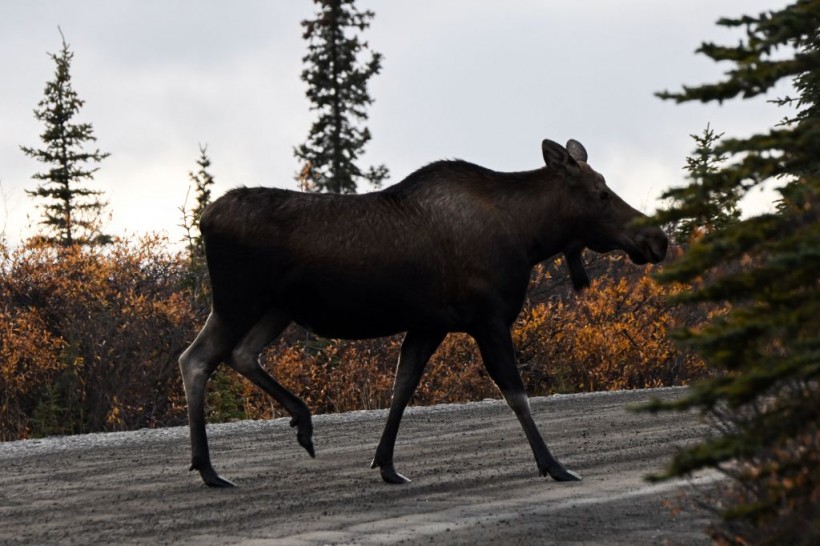
The first rabid moose reported in Alaska was euthanized after charging at locals.
After charging at locals, the first rabid moose documented in Alaska was euthanized. In its necropsy, the animal tested positive for Arctic Fox rabies.
The moose was slain, according to the state's Department of Fish and Game, after it was spotted prowling around Teller, Alaska, and charging at onlookers.
First Rabid Moose in Alaska
According to the Alaska Department of Fish and Game, the moose had exposed areas of skin, was unstable, tripping, and drooling a lot.
Dr. Kimberlee Beckmen, the department's wildlife veterinarian, was contacted, samples from the moose were taken, and submitted for testing, and the animal's remains were burnt out of caution, according to agency personnel.
The incident, according to officials, represented the state's first officially documented instance of rabies in a moose.
Necropsy Results
The Centers for Disease Control and Prevention verified the virus was an Arctic Fox rabies variation the next day, according to a press release, after the Alaska State Virology Laboratory discovered rabies in the moose's brain during a necropsy on Monday.
While this was the first moose to be diagnosed with rabies in Alaska, there have been previous occurrences in South Dakota, Minnesota, Canada, and Russia.
https://t.co/LzZfh9fORz— Alaska's News Source (@AKNewsNow) June 8, 2023
According to Fish and Game authorities, the moose likely caught the virus from a fox because it was the same version that was circulating in red foxes during the epidemic in the Nome and Seward Peninsula along with North Slope arctic foxes this past winter.
Moose rabies diagnoses are uncommon, although they have been found in South Dakota, Minnesota, Canada, and Russia, according to Fish and Game authorities.
Only moose in Alaska that exhibit neurologic symptoms are examined for rabies, according to authorities.
Tested Positive
Fish and Game authorities said they want to increase rabies monitoring as a result of the recent occurrence by analyzing all brain samples taken from mammals discovered dead or put down in areas where fox rabies is an enzootic disease.
Avoid approaching any mammals that have been found dead or that are exhibiting rabies symptoms. According to USA Today, symptoms include excessive salivation, unusual or aggressive behavior, and bite marks.
The Alaska Department of Fish and Game added in an official statement that although individual instances like this one are uncommon, rabies outbreaks in the moose population are extremely unlikely given their primarily solitary nature.
Also Read: Invasive Marsupial Opossums Being Hunted Down in Alaska
Rabies
The most common way that rabies, an avoidable viral illness, is spread is by the bite of a rabid animal. The rabies virus affects mammals' central nervous systems, which eventually results in brain illness and death. Although any mammal can contract rabies, the great majority of cases that are documented each year involve wild animals.
Only mammals are afflicted by rabies. Warm-blooded creatures with fur are known as mammals. Mammals include people as well. Since birds, snakes, and fish are not mammals, neither they nor you can contract rabies from them. However, rabies may infect any creature, including humans.
About 60,000 Americans receive post-exposure prophylaxis (PEP) each year to prevent infection with rabies after receiving a scratch or bite from an infected or suspected infected animal, even though rabies in humans is uncommon in the United States, with just 1 to 3 cases documented yearly, according to Centers for Disease Control and Prevention.
Related Article: Moose Samples Buttery Popcorn in Alaska Movie Theater
© 2024 NatureWorldNews.com All rights reserved. Do not reproduce without permission.

![Tsunami Hazard Zones: New US Map Shows Places at Risk of Flooding and Tsunamis Amid Rising Sea Levels [NOAA]](https://1471793142.rsc.cdn77.org/data/thumbs/full/70325/280/157/50/40/tsunami-hazard-zones-new-us-map-shows-places-at-risk-of-flooding-and-tsunamis-amid-rising-sea-levels-noaa.jpg)



